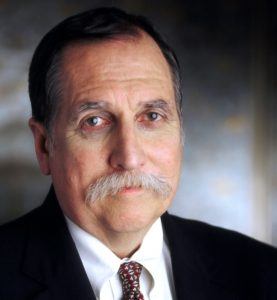Urban land planner says mixed-use development revitalizing American downtowns, communities
by August 3, 2016 4:05 pm 427 views

Mixed-use developments in downtowns across the U.S. are making a comeback, replacing “big box” developments, look-a-like shopping centers and unplanned urban sprawl that has decimated the character and beauty of communities across the U.S.
That’s the view of an influential Washington, D.C.-based urban planner who spoke Wednesday (Aug 3) during a stop in Arkansas.
“The future belongs to mix-use,” Ed McMahon, senior resident fellow at the Urban Land Institute. “All over America, downtowns are coming back.”
McMahon was the luncheon guest at the University of Central Arkansas’s Community Development Institute and Division of Outreach and Community Engagement in downtown Conway today. He also was the keynote speaker at a special program later in the day to commemorate UCA’s urban planning institute’s 30th anniversary.
McMahon holds the Charles E. Fraser Chair on Sustainable Development and Environmental Policy at the Washington, D.C.-based think tank. He is nationally known as a leading authority on topics such as the links between health and the built environment, sustainable development, land conservation, smart growth, and historic preservation.
At both Conway events, McMahon gave an hour-long presentation highlighting economic, technological and demographic trends that are reshaping American cities and towns. McMahon championed the view that communities can grow without losing their distinctive character or quality of life.

In complimenting Conway city officials, planners and community leaders on maintaining the distinctive, small-town charm and character of the city’s downtown area, the city planner also offered strategies he said successful communities can use to grow their economies while preserving the places that people love.
“Communities deteriorate one building, one project at a time,” he said. “That’s also how they get better.”
In his engaging slideshow, McMahon showed dozens of before-and-after photos of rural and large cities that have seen dynamic economic growth and development because city leaders and planners decided to take charge of local planning and land-use development.
He told the roomful of about 30 UCA and Conway officials that growth is inevitable for most cities and communities across the U.S., but local leaders need a long-range plan that preserves historic and important physical structures and protects what makes that community unique and different.
“What places in Conway are worth preserving?” he asked the local group. “There should be a sense of place that make the physical surroundings in every community worth caring about.”
In citing examples of cities that have successfully implemented long-range economic development plans for downtown areas, McMahon said city planners shouldn’t make the mistake of destroying such local treasures as New Orleans’ French Quarters, Seattle’s Pike Place, San Antonio’s Riverwalk and South Miami’s unique art deco architecture.
“If you don’t plan for a healthy downtown, then you won’t have a healthy downtown,” said McMahon, who served as a urban planning consultant for New Orleans following Hurricane Katrina.
He also decried the past 50 years of urban development he said has made most America cities look and feel the same. He said he could get in a helicopter and land in many American communities and would not know where he was.
“So many of our towns look like they were built by Legos … because they all look the same,” McMahon said of shopping developments, big box stores and suburban sprawl.
While speaking in length on how uninspired residential and commercial planning has created sprawl and left blocks of empty “big box” real estate developments in many U.S. cities, McMahon also commended Walmart for the retail giant’s recent efforts to build more mixed-use projects in urban communities.
In his hometown, McMahon said he was astonished when Walmart opened its first two stores in the nation’s capital. The 80,000-square-foot store is located in a mixed-use building topped by four stories of apartments. Parking is located in a garage directly below the store, and another 10,000 square feet of retail space is wrapped around the outside of the Walmart with such tenants as Starbucks.
“This is not your typical Walmart,” he said.
McMahon also said he also made a recent trip to Northwest Arkansas and was amazed to see a similar mixed-use Walmart location in downtown Bentonville, headquarters of the nation’s largest retailer. He said he believes the retail giant will see a substantial spike in same-store sales in urban areas where they stick to this strategy.
